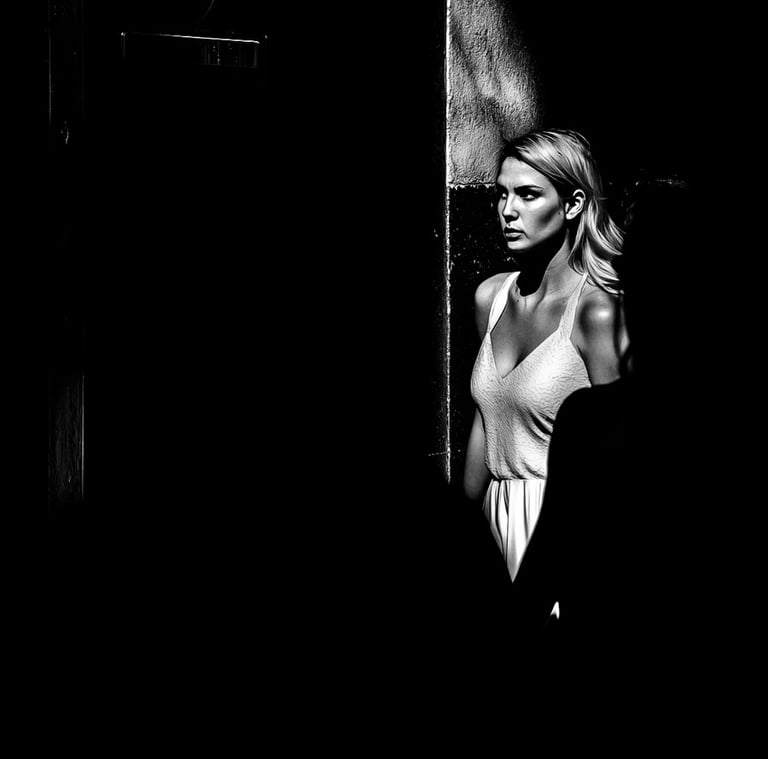Mastering Chiaroscuro in Street Photography: The Art of Light and Shadow
Embracing Chiaroscuro in Street Photography: Beyond Black and White
In the dynamic and unpredictable world of street photography, we often find ourselves chasing moments that encapsulate the raw essence of daily life. It’s a dance of timing, intuition, and vision, where one frame can tell a thousand stories. Inspired by the legendary Henri Cartier-Bresson and his concept of the decisive moment, our group has long valued the authenticity of these spontaneous instances, capturing them with a keen eye for tonal range and subtlety. While black and white photography strips away the distractions of colour, it allows the nuances of light, shadow, and emotion to come to the forefront. Yet, there’s a concept from the art world that can take our practice to even greater heights: Chiaroscuro.
Understanding Chiaroscuro: Light Meets Dark
Chiaroscuro, originating from the Italian words chiaro meaning "light" and oscuro meaning "dark," is a term historically associated with the dramatic interplay between light and shadow. In classical painting, it was used to create depth, drama, and an almost three-dimensional effect on flat surfaces. Masters such as Caravaggio, Rembrandt, and Leonardo da Vinci utilized chiaroscuro to give life to their figures, portraying not only physical form but also the emotional weight of the scene. For them, light was not just a tool for visibility; it was a conduit for storytelling.
In street photography, Chiaroscuro may not manifest as the extreme contrasts seen in classical painting, but it can serve as a nuanced tool to help us explore the depth and dimensionality of our everyday scenes. When done right, it enhances our images by layering subtle contrasts, balancing the interplay between light and dark in ways that mirror the complexity of human life itself.
Subtle Tonal Contrasts: Capturing Depth and Realism
While our ethos as street photographers often leans away from harsh extremes of black and white, Chiaroscuro can offer a more refined path. It’s not always about stark contrasts or high drama; rather, it’s about capturing the gentle gradations of tone—the delicate dance between light and shadow that breathes life into a scene. By embracing these subtleties, our photographs can move beyond flat two-dimensional representations and instead convey a sense of depth, realism, and atmosphere that pulls the viewer into the moment as it was truly experienced.
Consider a narrow alleyway, where the light trickles in from a nearby streetlamp. The shadowy recesses may seem like negative space at first, but within them lies texture, detail, and mood. This interplay allows us to create images that resonate emotionally, providing a more immersive experience for the viewer. By focusing on the subtleties of light transitions, we can portray not just the scene itself but the atmosphere and emotion within it. Chiaroscuro becomes a method of seeing, of identifying where light falls and where shadow lingers, and how these two forces work together to shape the world around us.
Emotional Depth Through Light and Shadow
Chiaroscuro is not merely a visual technique; it’s deeply emotional. The careful use of light and shadow allows us to inject mood, drama, and atmosphere into our images. It’s an approach that lets us explore deeper narratives—those not immediately visible on the surface but felt in the undercurrents of the moment. Through the contrast of light and shadow, we can represent the highs and lows of human experience, capturing not just a scene but the stories and sentiments that it carries.
Imagine capturing a scene of a lone figure sitting quietly on a park bench, the late afternoon sun casting long shadows across the ground. The figure is half in shadow, half bathed in light—an image that hints at both solitude and contemplation. This delicate balance of light and dark can add emotional layers to the scene, turning an otherwise ordinary moment into something profound.
Guiding the Viewer’s Eye: Focusing Through Contrast
As painters use Chiaroscuro to draw attention to the focal points in their compositions, street photographers can use natural contrasts in light to guide the viewer’s eye. The strategic use of light can isolate subjects, direct attention to specific elements within the frame, and ultimately tell a more cohesive story. By learning how to manipulate the interplay between light and dark, we as photographers can subtly control how our viewers experience our images.
Take, for example, a bustling market scene. Amid the chaos, a shaft of light illuminates a vendor’s face, drawing the eye directly to their expression while the surrounding market falls into shadow. This controlled use of light not only emphasizes the subject but also conveys a narrative about the relationship between the individual and their environment. In this way, Chiaroscuro becomes more than just a technique—it becomes a storytelling device that guides the viewer through the visual experience.


Composition and Harmony: Crafting Balance in Your Frame
Chiaroscuro isn’t solely about extremes; it’s also about balance. Finding the right interplay between light and dark areas within your composition can lead to more harmonious and aesthetically pleasing images. This balance doesn’t detract from the candid nature of street photography; instead, it adds a layer of artistic intention to the work, elevating it beyond mere documentation.
A photograph that utilizes Chiaroscuro effectively can become a study in composition itself. By carefully balancing the elements of light and shadow, we can create a sense of equilibrium that draws the viewer in and keeps them engaged with the image. A well-balanced composition allows for a more dynamic interaction between the various components of the scene, enhancing both the visual impact and the emotional resonance of the photograph.
A Creative Endeavour: Pushing Boundaries and Experimenting
Exploring the nuances of Chiaroscuro in street photography is a creative journey that challenges us to see the world in new ways. It encourages us to experiment with different lighting conditions, to play with shadow as much as light, and to push the boundaries of what we consider a compelling street image. The dynamic interaction between light and dark encourages a level of experimentation that can breathe new life into even the most familiar streets and scenes.
While embracing Chiaroscuro doesn’t require us to change our philosophy or style, it does offer an opportunity to enrich our practice. It pushes us to look beyond the surface and to engage more deeply with the scenes we capture. By incorporating these principles into our work, we can continue to capture authentic, candid moments with an added depth that transcends the ordinary and touches on the extraordinary.
Conclusion: Embracing Chiaroscuro in Street Photography
Incorporating Chiaroscuro into our street photography is not about abandoning our core beliefs; rather, it’s about adding another layer of depth and complexity to our craft. By understanding and applying the principles of light and shadow, we can continue to capture the fleeting, spontaneous moments that define street photography—only now with a richer, more pronounced narrative quality. As street photographers, we are constantly evolving, constantly seeking new ways to tell stories with our cameras. And by embracing the interplay of light and shadow, we invite a new dimension into our work, one that reveals the world not just as it is seen, but as it is felt. Let us step out, cameras in hand, and embrace the light and shadow dance of Chiaroscuro in our quest to freeze those fleeting, telling moments of life on the streets.
So the next time you’re out with your camera, remember to look for the light—and the shadow it casts. They just might guide you to your next decisive moment.
Copyright © 2025 Peter Pickering. All Rights Reserved. All Wrongs Reversed.
🌐 peterpickering.com | 🎺 sessionsonthegreen.com | 💜 isaacbcole.com | ▶️ YouTube Channel | 🌿 life.peterpickering.com


